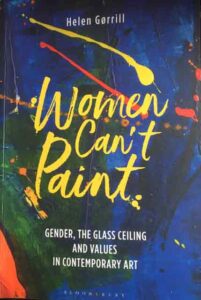Mary Fletcher

The regrettable title of this book, which I deplore, is taken from a remark by Georg Baselitz.
At the start of the first chapter Gorrill refers to “masculinities and femininities in contemporary art” that I see as perpetuating unhelpful stereotypes. There is a continued muddle about these terms in the book, which would have been better if it had kept clearly to being about the question of how successful women and men are at present as painters, and the reasons for this.
The author has compiled a lot of worthy research using graphs and percentages to show the continuing position of women artists as making less money than male artists, being collected less by museums, winning fewer prizes, etc. Many reasons are given, such as women being impeded by more childcare, less networking, and sexism and ageism in society.
We are probably all aware of many examples, but Helen Gorrill has put in the graft to prove the unequal state of affairs in the area of painting. It’s impressive but rather dull and repetitive. There are no photographs of paintings, and as Alice said, “what good is a book without any pictures?” Many remarks are attributed to anonymous women, which makes these artists seem lacking in guts if they can’t own their views openly.
At the end the author proposes a few solutions that require quotas and equality rules in institutions and research funding. Ending with the words “let the revolution begin” seems strange when many of us are well aware of all the work already done which can be built on.
The pathetic ridicule heaped on this book by the reviewer Alexander Adams in The Critic magazine serves to illustrate why such a book has been written.
Volume 35 no 4 March/April 2021
